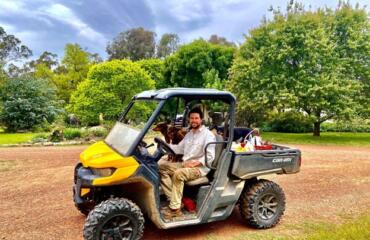
Burnt out homes sit above the Great Ocean Road at Wye River. Pic: The Age
Property owners had been pushing for the vegetation along the border of the townships and forest to be cleared to create a so-called Asset Protection Zone that would provide a buffer to prevent a future fire from reaching homes.

But bushfire experts appointed by the Department of Environment, Land, Water and Planning found that the terrain of Wye River and Separation Creek made this impossible, although some properties could benefit from selective clearing.
Victoria’s Emergency Management Commissioner, Craig Lapsley, who helped bring together the experts, said that clearing alone would not be enough to bring down the area’s Bushfire Attack Levels, which measure the fire risk of properties and can impact rebuilding costs.
The regulations, which were imposed on the communities by the State Government in March, assign each property a level according to its proximity to bush, the slope of the land it occupies and the overall fire risk of the region.
“The Asset Protection Zone has a place, but it’s not the silver bullet,” Mr Lapsley said. “There are multiple layers of things you need to do [to lower Bushfire Attack Levels] . . . I think it’s important to see the Asset Protection Zone is only one of those layers, which is aimed at reducing intensity.”
More than 100 homes were lost in the Christmas Day blaze, which continued for several weeks, skirting the Great Ocean Road and at one stage threatening the resort town of Lorne to the east.
“The Asset Protection Zone has a place, but it’s not the silver bullet. There are multiple layers of things you need to do [to lower Bushfire Attack Levels].” — Craig Lapsley, Emergency Management Commissioner (Victoria)
Diane Sisely, whose holiday home in Wye River was among those lost in last year’s fire, remained hopeful that an Asset Protection Zone, which have been successfully introduced to protect other townships along the Great Ocean Road, could lower the cost of rebuilding for some residents.
“We all share responsibility for this, not just some and not just residents,” said Ms Sisely, who is co-chairing a committee that is campaigning for fire protection costs of the townships to be shared with state and local governments.
More than 70 properties hardest hit by the fire have been given a complete or partial Flame Zone rating, the highest risk category, as part of the new classification system.
“Unfortunately, this was done without consultation with the community and without the possibility of a review,” Ms Sisely told The Citizen.
The cost of rebuilding to Flame Zone standard can vary depending on the design and materials used, but insurance companies estimate the additional expense to range between $65,000 and $277,000.
“At the moment, the proposal is that it’s solely the residents who bear the responsibility for protecting against fire through the Bushfire Attack Levels,” Ms Sisely said.
“[But if] undergrowth is cleared for, say, up to 50 metres, that provides a buffer for those houses on the perimeter [of the townships] and might mean . . . they wouldn’t need to build to the Flame Zone [requirements].”
A spokesperson from the Department of Environment, Land, Water and Planning told The Citizen that clearing could help lower the risk of some properties with a Flame Zone rating by one category.
“We all share responsibility for this, not just some and not just residents . . . At the moment, the proposal is that it’s solely the residents who bear the responsibility for protecting against fire through the Bushfire Attack Levels.” — Diane Sisely, Wye River property owner
Ms Sisely said although the experts had found clearing would be unable to protect every property, this was not necessarily a loss for the whole community.
“What we’re learning is that there’s not just one way in how we can approach this,” she said.
The application of Bushfire Attack Levels has been widely criticised by the community.
But Mr Lapsley said that the regulations, which incorporate the recommendations of the 2009 Victorian Bushfire Royal Commission, were solid.
“We’ve got to build to the history of what fire does in Australia and particularly Victoria,” Mr Lapsley said.
A recent report by the CSIRO found that the majority of damage to homes in the Christmas Day fire had been caused from within the townships by debris from the trees and combustible building materials.
“There’s no doubt the fire in Wye River was moving house to house,” Mr Lapsley said.
“It was how the fire behaved within the built area of the town as much as what it did for the forested areas.”

CSIRO bushfire researcher Justin Leonard, one of the experts consulted by authorities, said an Asset Protection Zone could be used as a cost trade-off between the residents and the government.
“I guess the challenges are: who maintains it? How do you make sure it’s maintained at the time?” Mr Leonard said. “That doesn’t change the fact that Wye River is inherently combustible.”
The CSIRO report also recommended that avoiding timber retaining walls, improving the management of the vegetation immediately around a home and not storing flammable materials under houses were key measures that could improve safety.
Mr Leonard said regardless of whether the clearing was implemented he would work with home owners to help them understand how to meet the regulatory requirements and still save costs.
“There are a whole lot of little extra things they can do to address the fact that they are in that fire prone township,” Mr Leonard said.
► This story was also published in The Age.



